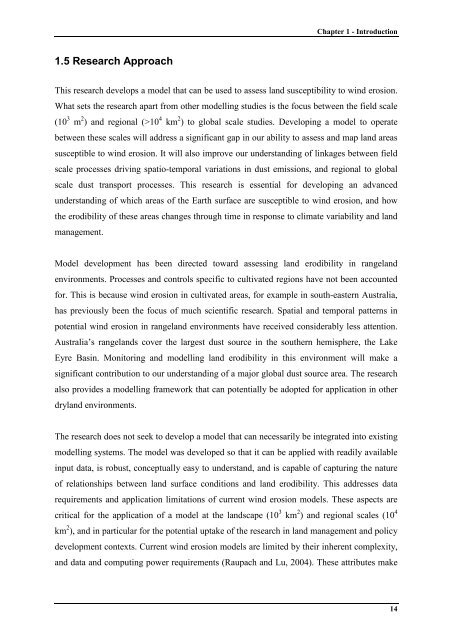Wind Erosion in Western Queensland Australia
Modelling Land Susceptibility to Wind Erosion in Western ... - Ninti One
Modelling Land Susceptibility to Wind Erosion in Western ... - Ninti One
Create successful ePaper yourself
Turn your PDF publications into a flip-book with our unique Google optimized e-Paper software.
Chapter 1 - Introduction1.5 Research ApproachThis research develops a model that can be used to assess land susceptibility to w<strong>in</strong>d erosion.What sets the research apart from other modell<strong>in</strong>g studies is the focus between the field scale(10 3 m 2 ) and regional (>10 4 km 2 ) to global scale studies. Develop<strong>in</strong>g a model to operatebetween these scales will address a significant gap <strong>in</strong> our ability to assess and map land areassusceptible to w<strong>in</strong>d erosion. It will also improve our understand<strong>in</strong>g of l<strong>in</strong>kages between fieldscale processes driv<strong>in</strong>g spatio-temporal variations <strong>in</strong> dust emissions, and regional to globalscale dust transport processes. This research is essential for develop<strong>in</strong>g an advancedunderstand<strong>in</strong>g of which areas of the Earth surface are susceptible to w<strong>in</strong>d erosion, and howthe erodibility of these areas changes through time <strong>in</strong> response to climate variability and landmanagement.Model development has been directed toward assess<strong>in</strong>g land erodibility <strong>in</strong> rangelandenvironments. Processes and controls specific to cultivated regions have not been accountedfor. This is because w<strong>in</strong>d erosion <strong>in</strong> cultivated areas, for example <strong>in</strong> south-eastern <strong>Australia</strong>,has previously been the focus of much scientific research. Spatial and temporal patterns <strong>in</strong>potential w<strong>in</strong>d erosion <strong>in</strong> rangeland environments have received considerably less attention.<strong>Australia</strong>’s rangelands cover the largest dust source <strong>in</strong> the southern hemisphere, the LakeEyre Bas<strong>in</strong>. Monitor<strong>in</strong>g and modell<strong>in</strong>g land erodibility <strong>in</strong> this environment will make asignificant contribution to our understand<strong>in</strong>g of a major global dust source area. The researchalso provides a modell<strong>in</strong>g framework that can potentially be adopted for application <strong>in</strong> otherdryland environments.The research does not seek to develop a model that can necessarily be <strong>in</strong>tegrated <strong>in</strong>to exist<strong>in</strong>gmodell<strong>in</strong>g systems. The model was developed so that it can be applied with readily available<strong>in</strong>put data, is robust, conceptually easy to understand, and is capable of captur<strong>in</strong>g the natureof relationships between land surface conditions and land erodibility. This addresses datarequirements and application limitations of current w<strong>in</strong>d erosion models. These aspects arecritical for the application of a model at the landscape (10 3 km 2 ) and regional scales (10 4km 2 ), and <strong>in</strong> particular for the potential uptake of the research <strong>in</strong> land management and policydevelopment contexts. Current w<strong>in</strong>d erosion models are limited by their <strong>in</strong>herent complexity,and data and comput<strong>in</strong>g power requirements (Raupach and Lu, 2004). These attributes make14
















